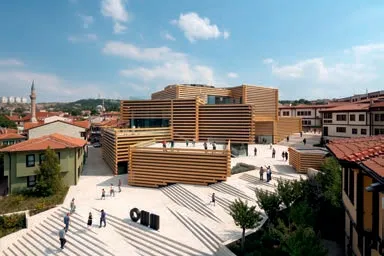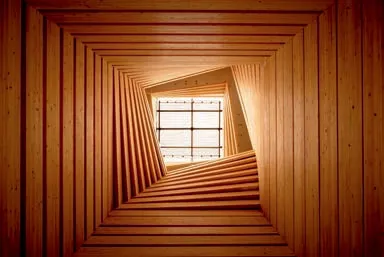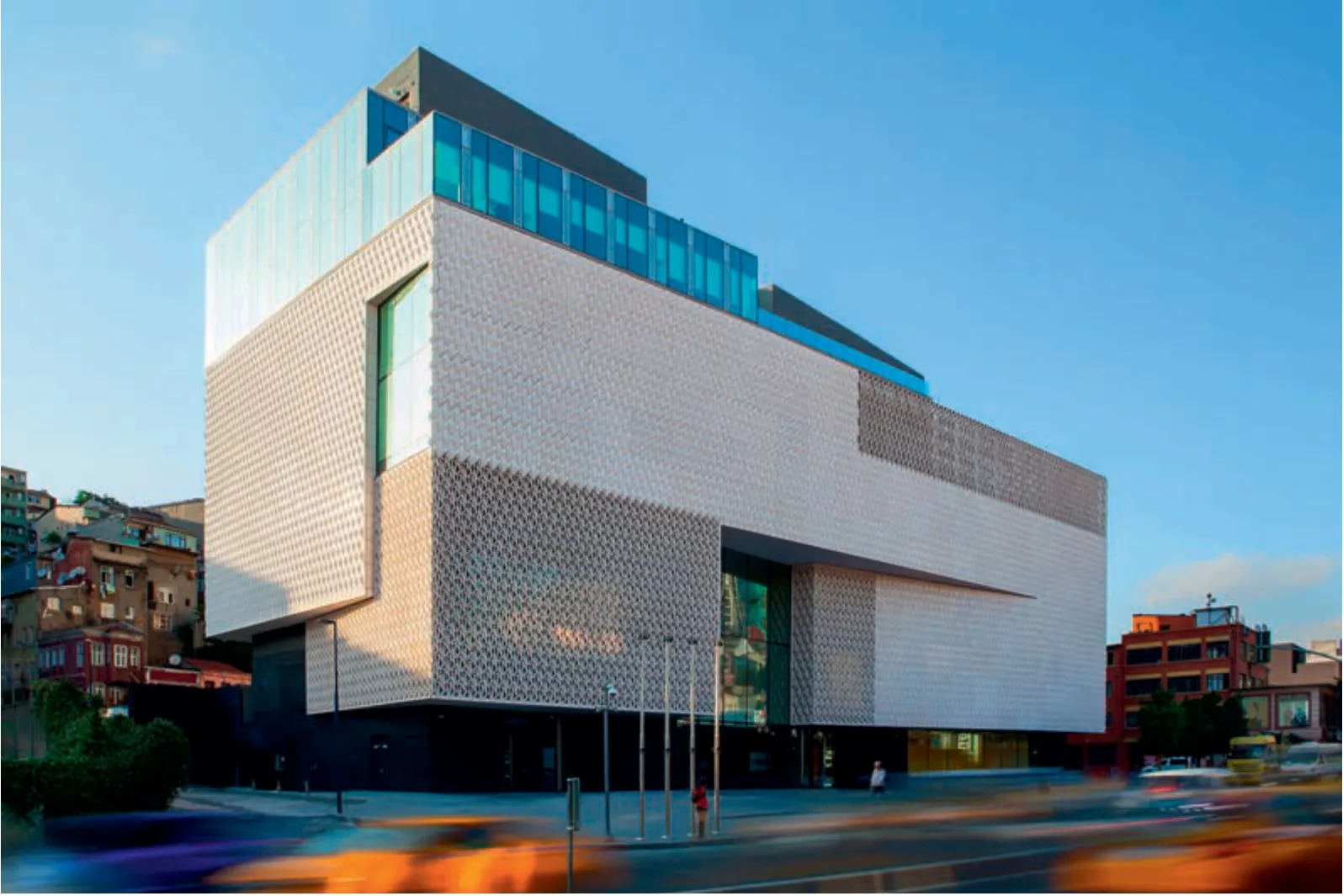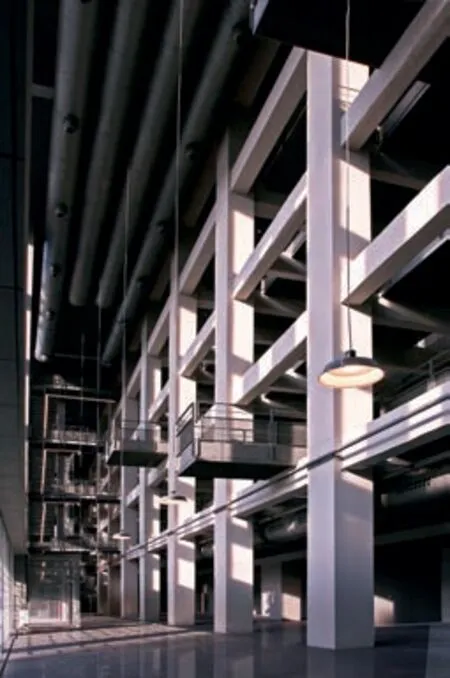缪斯女神的圣殿:论艺术博物馆和中东地区
2020-04-28谢布内姆于杰尔ebnemcel
谢布内姆·于杰尔/Şebnem Yücel
徐知兰 译/Translated by XU Zhilan
海湾地区:通过文化资本获利
过去20 年间,海湾地区还没有什么其他建筑类型能像博物馆一样在建筑界崭露头角1)[1]231-244。就算是那些全球闻名的建筑师事务所初步公布的设计成果也能引起人们广泛关注和兴奋不已。考虑到博物馆在新兴经济产业品牌推广和市场营销中的重要作用,海湾地区涌现的博物馆潮流并不出人意料。学者凯伦·埃克塞尔把博物馆定义为“国家的象征和全球化体系中的文化货币”[2]8。她表述了事实上,博物馆在象征意义和建筑学方面都具有超越任何其他建筑类型的重要性。根据埃克塞尔的观点,博物馆确实反映了“乌托邦的远大理想和文明与国家的概念”[2]9,并能由此表达国家的政治抱负和文化理想。这就是为什么人们对于那些过去处于“边缘”地位、而今却获得了更强势的经济发展地位的国家正在通过其博物馆建设活动企图在全球化视野中寻求新地位的事实毫不诧异,其中最新的建设项目是让·努维尔工作室2019 年设计的卡塔尔国家博物馆。
这波博物馆狂潮始于2008 年由贝-考伯-弗里德事务所设计,位于多哈的卡塔尔伊斯兰艺术博物馆的建成开放。紧随其后的是“迈特海夫”i——即位于多哈的阿拉伯当代艺术博物馆,它于2010 年建成开放,在当时一跃成为游戏规则的颠覆者。它之所以能做到这一点,不仅是因为低调的建筑造型——其目前的“临时”场馆是一所旧校舍改造建成的,由让·弗朗索瓦·博丹设计——也是因为这座博物馆拥有丰富的现代艺术藏品2)[3]。沿着这个方向,又继续产生了阿布扎比酋长国萨迪亚特岛(快乐岛)上的一系列博物馆建筑。萨迪亚特岛是一个由阿布扎比酋长国旅游部门着手开发的文化、居住和商业综合地产项目。岛上建成开发的第一座博物馆是著名的阿布扎比卢浮宫,由让·努维尔工作室设计,于2017 年开放。目前,另有两座博物馆项目仍在萨迪亚特岛上进行施工建设。一座是福斯特建筑师事务所设计的扎耶德国家博物馆,预计将于今年——即2020 年建成开放。另一座则是盖里建筑师事务所设计的阿布扎比古根海姆美术馆,工程在经过多次延期后终于进入了施工阶段3),延期的原因包括海湾劳工艺术家联盟发起的好几次抗议活动。

1 阿布扎比卢浮宫外景/Louvre Abu Dhabi, exterior view(摄影/Photo: Mohamed Somji,供图/Courtesy of Department of Culture and Tourism - Abu Dhabi)
在所有这些博物馆里,激起了最大争议的项目恐怕是阿布扎比卢浮宫,肇始于2007 年阿拉伯联合酋长国和法国共同签署的合作协议声明(图1)。提出这些争议的理由和将卢浮宫的名称同一座位于海湾地区的博物馆联系在一起的行为有关,争议的内容特别强调了法国如何为了石油美元而“出卖其灵魂”4)[4]。在阿联酋人看来,他们建设一座与卢浮宫有关的艺术博物馆的意图,其实不完全是为了纯粹的经济利益,而更像是为了获取文化资本,由此将其融入一项更宏大的文化计划之中5)[5]。但是,作为一种无法通过收购或运输获取的资本形式,文化资本很难得到,却又是一个国家在国际上取得令人渴望的新地位所必不可少的资本。文化资本的获取必须得到由“公认的”文化资本所有者组成的更大范围的国际社会认同才能实现,而这些资本所有者不总是由国家来代表——由此,文化资本是社会和文化阶层的标志。在某种程度上,那些对卢浮宫出借其名称给一座博物馆——尤其是一座位于海湾地区的博物馆的抗议,以及其他对海湾地区艺术博物馆的讨论,总体上仍然更多地和阿联酋与法国的身份认同相关——而不仅仅与旅游、文化和经济事务有关。这当然是一个深刻的问题,对这个问题的看法很容易受到到处盛行的刻板印象和偏见的影响,而这些刻板印象和偏见又脱胎于欧洲中心主义的世界观。正如2014 年玛格丽特·罗西特曾对每个人发出提醒道:“……卢浮宫的藏品不是出于被国王们收购、用来炫耀财富和权力的目的获取的,就是在19 世纪从海外领地或欠发达国家掠夺回来的。但至少,阿联酋人为艺术和专业知识的取得付出了公平的代价。”[6]但就和在她之前也有许多人针对东方主义刻板印象发出了反刻板印象的评论一样,她的这些话也被人们轻而易举地忘记了。

2 奥敦帕扎勒当代博物馆外景/OMM, exterior view(摄影/Photo: ©NAARO,供图/Courtesy of OMM)

3 奥敦帕扎勒当代博物馆入口广场/OMM, entrance plaza(摄影/Photo: ©NAARO,供图/Courtesy of OMM)
The Gulf: Cashing in on the Cultural Capital
In the past two decades no building type from the Gulf region have been more significant than museum buildings in making the headlines in the architectural world1)[1]231-244.Even the first display of their designs by world-renown offices have been enough to stir excitement as well as discussions.Considering the important role museums play in branding and marketing emergent economies, the museum boom in the Gulf region is not surprising.As Karen Exell locates museums as "symbols of the nation and as cultural currency in the global system"[2]8, she underlies the fact that this symbolic and architectural importance surpass that of any other building type.According to Exell, museums do project "the utopian ambitions and notions of civilization and the nation state"[2]9and as such they give expression to the cultural and political aspirations of the nation states.That's why it is not surprising that, countries that were formerly placed at the "periphery" and reached a stronger economic power today, are looking for a new place in the global scene through museums they are building, the most recent addition being the National Museum of Qatar by Ateliers Jean Nouvel in 2019.

4 奥敦帕扎勒当代博物馆主中庭景象/OMM, view towards the main atrium.(摄影/Photo: ©Batuhan Keskiner,供图/Courtesy of OMM)
The museum craze started with the opening of Qatar's Museum of Islamic Art in Doha in 2008 by Pei Cobb Freed & Partners.It was followed by MATHAF: Arab Museum of Modern Art in Doha in 2010, a game changer not through its modest architecture—its "temporary" home was transformed from an old school building by Jean-François Bodin—but also through its modern content2)[3].Next in line was a select list of museums from Abu Dhabi's Saadiyat Island (Island of Happiness), a cultural, residential and business development project embarked upon by Abu Dhabi Tourism Authority.First museum to be opened in Saadiyat was famed Louvre Abu Dhabi in 2017,designed by Ateliers Jean Nouvel.Today, two other museum projects are still underway in Saadiyat:the first one is Zayed National Museum by Foster +Partners, which is expected to be opened in 2021.The other one is Guggenheim Abu Dhabi by Gehry Partners, construction of which has finally set to start3)after many delays, including the ones caused by the protests by Gulf Labor Coalition.
Among all, probably the biggest news that stirred talks was Louvre Abu Dhabi, starting with the announcement of the partnership deal made by UAE and France in 2007 (Fig.1).The reasons for the talks were related with the affiliation of the Louvre's name with a museum in the Gulf, putting a stress on how France was "selling its soul" for petro dollars4)[4].On the part of the Emiratis, the intention for creating an arts museum, the one affiliated with the Louvre,was clearly not stemming from a purely economic endeavor, rather it was part of a larger cultural project as a means of acquiring cultural capital5)[5].However,as a form of capital that cannot be purchased or transported, the cultural capital needed to secure a new, more desired place in the world proved to be hard to acquire.It required an approval from a larger community of "recognised" cultural capital owners- not always represented by the states - and as such it served as a social and cultural class marker.In a way, the protests on Louvre lending its name to a museum in the Gulf in specific, and the discussions on arts museum in the Gulf in general were more about identity, of both Emirates and the France, than tourism, culture and economy.Naturally this is a deeply problematic outlook, one that is susceptible to power parade of stereotypes and prejudices that are the offshoots of Eurocentric world vision.While Caroline Rossiter reminded everyone in 2014 that"[...] the Louvre collections were bought by kings to show off wealth and power, or pillaged from occupied or less developed countries in the 19th century.At least the Emiratis are paying a fair price for the art and the expertise"[6], her words were forgotten easily,like many stereotype-defying comments made against orientalist stereotypes before hers.
The Eastern Mediterranean: Contested Sites,Celebrated Beginnings
Considering the larger Middle East, there are more art museums underway, especially in Turkey and Lebanon.Even though these museums were also designed by equally renown architectural offices the news on them did not stir an international debate anywhere near to the ones caused by the Gulf museums.Main reason for this might be the absence of the involvement, i.e.name-lending, of a major Western cultural institution.However,despite the prevalence of similar prejudices towards them, the existence of a more established, and an internationally recognised contemporary arts scene in both countries might be another reason for it.
In 2015, Amale Androas' WORKac was selected to design Lebanon's Beirut Museum of Art (BeMA),and the museum is expected to be opened in 2023.The museum is planned to be located in Beirut's "Museum Mile", that will house many more museums like the National Museum and Museum of Lebanese Prehistory,the Beirut City History Museum...etc. In 2019 Turkey also has experienced a boost in arts museums, all of which were private initiatives: two modern arts museums were opened, another one was pre-opened during the biennale, and the news on the new home for Istanbul Modern has arrived.Out of the four, three were located in Istanbul, the heart of the country's contemporary arts scene, and one was located in Eskişehir, a mid-sized university town in mid-Western Anatolia6), a surprising addition to the list.
地中海东部:有争议的场地,著名的开幕仪式
如果考虑到更大范围的中东地区,其实有更多的艺术博物馆正在建设中,尤其是在土耳其和黎巴嫩。但即使那些博物馆也是由同样知名的建筑师事务所做的设计,和它们相关的新闻却远未激起像针对位于海湾地区的博物馆项目一样的国际争议。其中的主要原因可能是缺乏关联感,也就是从西方的重要文化机构借用名称的事件。然而,尽管针对这些博物馆的类似偏见也同样盛行,在阿联酋和法国这两国都已有更成熟和广为国际社会所认可的当代艺术圈,可能也是一个原因。
2015 年,阿玛尔·安德拉奥斯建筑事务所入选成为黎巴嫩贝鲁特艺术博物馆(BeMA)的设计方,这座博物馆预计将于2023 年开幕。博物馆的场地被规划在贝鲁特的“博物馆大道”上,那里还有许多像国家博物馆、黎巴嫩史前博物馆和贝鲁特城市历史博物馆等类似的其他博物馆。土耳其于2019 年也经历了一波艺术博物馆的建设浪潮,当时所有的新建项目都是私人博物馆——其中两座现已开放,另一座将在土耳其双年展期间重新开放,最近还传来了伊斯坦布尔博物馆新馆的消息。在这4 座博物馆中,有3 座都位于伊斯坦布尔——这个国家的当代艺术圈中心,另一座则位于埃斯基谢希尔——是一座位于西安那托利亚中部的中尺度大学城6),它的出现有些出人意料。
这座位于埃斯基谢希尔的奥敦帕扎勒当代博物馆(OMM)已于2019 年9 月8 日对公众开放7)(图2)。人们希望这座由著名的隈研吾合伙人建筑师事务所(KKAA)设计的博物馆能在埃斯基谢希尔产生毕尔巴鄂效应8)[7]。博物馆的名称来自于其所在的地区名称“奥敦帕扎勒”,在土耳其语中的字面意思是“木材市场”。这里是这座城市的历史街区所在地,分布有许多塞尔柱王朝和奥斯曼帝国时期的宗教建筑,还有大量当地非常典型的木结构民居。显然,这片历史街区的名称和当地传统民居都为隈研吾建筑师事务所提供了设计灵感。在《日本时报》的一篇文章中,隈研吾建筑师事务所内负责该设计项目的合伙人池口友紀阐述了他们选择木材作为结构表现形式的手法与木材市场的概念有关,她补充道:“(在土耳其)也有专门的叠压和锁定加压木板材的专门区域,我们在奥敦帕扎勒当代博物馆也采用了类似的设计。”[7](图3)对隈研吾本人来说,一项重要的参考要素是邻里尺度的私密感,以及街区并非正交、而是随机分布的空间形态。这一特征正是隈研吾建筑师事务所喜欢的,他们把它转译到了奥敦帕扎勒当代博物馆的建筑形式上,“所以,这不仅和木材有关,也和木材的使用形式有关”[7],隈研吾这样表述(图4)。
雅特美术馆作为推动当代艺术发展和策展的非营利组织,于2019 年9 月13 日建成开放了他们位于在伊斯坦布尔的新馆,建筑由格雷姆肖建筑师事务所设计(图5)。雅特美术馆成立于2010 年,初创地址在塔克辛地区独立大街上一处比现在小得多的场馆9)。它在独立大街上运营了3 年之后,韦赫比-科奇基金会作为雅特美术馆的所有者,在2013 年为新的博物馆建筑组织了一次有补偿金的建筑设计竞赛。雅特美术馆的新址位于道拉普代莱地区,成立基金会的科奇家族把他们在片区内的一座旧厂房捐赠给了韦赫比-科奇基金会。在这片经济衰退的区域内驻扎着一些假人模特工作室,各类低收入人群混居其间,其中也有来自不同国家的移民,所以新馆的场地条件并不优越。但是,随着雅特美术馆进驻这一地区的消息传开后,一些艺术画廊也开始迁入这里,在某种程度上激发了整个地区未来的绅士化进程。
雅特美术馆的管理者却对其新馆所在的邻里街区反应非常敏锐。其敏锐感体现在各种细致入微的措施中,比如他们首先以书面形式为建设工程即将带来的各种不便向人们致歉,随后采取了一系列更实惠的措施,尤其是在与亚沙玛·代尔基金会ii合作完成了一项针对“邻里街区的社会与文化结构、以及我们的友邻们对雅特美术馆进驻道拉普代莱地区的期待、希望和担忧”的研究之后更为如此10)。在雅特美术馆的管理者继续与当地的管理部门、社区中心和各类非营利机构不断进行接触的同时,他们也为自己的友邻启动了一项会员计划,邀请附近街区的人们免费参与各项活动和学习计划。最后,他们每个月都与所在地的各个社区共同举办活动,参与者“包括艺术家、观众、合作方和邻里街坊,以鼓励不同社群之间彼此倾听和进行对话。”10)

5 雅特美术馆外景/Arter, exterior view.(摄影/Photo: @FluPhoto,供图/Courtesy of Arter)

6 从雅特美术馆的咖啡厅看向后广场/Arter, cafe looking towards the back plaza.(摄影/Photo: @FluPhoto,供图/Courtesy of Arter)

7 雅特美术馆看向天窗的内景/Arter, interior view towards the skylight.(摄影/Photo: @FluPhoto,供图/Courtesy of Arter)
Odunpazarı Modern Museum (OMM) in Eskişehir has opened its doors to public on September 8, 20197)(Fig.2).Designed by famous architectural office, Kengo Kuma and Associates (KKAA), the museum is expected to bring a Bilbao-esque boost to Eskişehir8)[7].The museum gets its name from the district it is located in, Odunpazarı,literally meaning the wood market.This is the historic part of the city housing religious structures from the Seljuk and Ottoman times, as well as traditional timber houses, typical of the region.Apparently both the name of the district and the traditional homes in the region were sources of inspiration for KKAA's design.In a Japan Times article Yuki Ikeguchi, the KKAA partner who was in charge of the design, stated that their choice to use wood for structural expression was related to the idea of timber yard and she added: "There are also areas of specialisation (in Turkey) of stacking and interlocking planks, which, for the OMM, we designed in a similar way."[7](Fig.3) For Kengo Kuma himself, an important reference point was the intimacy of the neighborhood's scale, and the topography of the district, which was not straight and had a random geometry.This feature was what KKAA liked and translated into the geometry of the OMM building: "So it's not only about the timber, it is about the geometry of how that timber is used"[7]stated Kuma (Fig.4).
Arter, a non-profit organisation for the production and exhibition of contemporary arts has opened the doors of its new building designed by Grimshaw Architects on September 13, 2019 in Istanbul (Fig.5).Arter was founded in 2010 and started first in a much smaller venue on Taksim's Istiklal Street9).After three years in Istiklal, the Vehbi Koç Foundation, owner of Arter, organised an invited, paid architectural design competition for a new museum building in 2013.The site of the new museum was located in Dolapdere district, where the Koç family owned an old industrial building that they donated to the Vehbi Koç Foundation.This was a rundown district housing mannequin ateliers and very mixed demographics of low-income groups, including migrants from different countries, the site was not an advantageous one.However, following the news of Arter coming to the district, the arts galleries started to move to the area, in a way igniting the future gentrification of the whole district.
The management of Arter, however, proved to be very sensitive regarding the neighbours of their museum.Their sensitivity gained action in small steps like sending a letter apologising for the inconvenience that would be caused by the construction first, and then it continued with more solid moves, especially after a collaborative research carried out with YADA foundation on "the social and cultural structure of the neighborhood as well as the expectations, hopes and worries of our neighbors concerning Arter's relocation to Dolapdere."10)While they continued to be in constant contact with the local authorities, community centers and NGO's, they also started a membership program for their neighbours, inviting adjacent quarters to events and learning programmes for free.Finally,they organised monthly get togethers with their communities, "including artists, visitors, partners and neighbors to encourage listening and dialogue amongst different groups."10)
Despite the museum's attempts at including and being included in the neighbourhood, the architecture of the building stands out from its surroundings by its sheer size and whiteness.At the front of the museum, transparent and rather inviting ground floor of the building is cut off from the pedestrian traffic of the district by means of a long, rectangular decorative pool that ends at the entrance checkpoint.However the order and control imposed at the entrance softens up in the interior by means of a main atrium and big openings, allowing various views of both the exhibition halls in the interior and the adjacent buildings on the exterior to be juxtaposed and fused into each other (Fig.6,7).11)
Mimar Sinan Fine Arts University's Istanbul Museum of Painting and Sculpture (IMPS) is, in principle, the oldest museum devoted to [modern]art in Turkey, and yet, since its founding in 1937,the museum has been closed for longer periods of time than it has been opened.During 2019 the new building for the museum, designed by Emre Arolat Architects (EAA), has opened its doors to public for a short duration of time, between September 14 to November 10, to house parts of the works exhibited for the 16th Istanbul Biennial (Fig.8).While the museum has not been opened officially, this preopening gave a good peek into the building for the curious architecture lovers.
The new building for the IMPS is transformed from an existing antrepot (bonded warehouse)building no:5, located in Karaköy district near Bosphorus, the former site of the customs port12).EAA explains the main design idea as follows:
When transforming the antrepot building into a museum, the reinforced concrete structure is kept as it is, while the walls and the slabs are removed in order to obtain a 3D, naked structural grid which will house the "containers" of the new museum.Directed by a curatorial approach, the art objects are to be categorised and collected inside these containers.[8]
Notwithstanding the fact that the degree to which this was a transformation is debatable, especially considering the destruction and re-building of the reinforced skeleton frame for structural reasons, the building's grid façade is a good reminder of the offices and the warehouse that were standing there.The big and longitudinally extending atrium welcomes the guests on entering, and it corresponds to the old office section.The rest of the museum, especially the main exhibition areas are made from containers, which seem to be plugged-in to the skeleton frame.Similar to their placement on the façade - projecting out of the skeleton frame and disrupting the order implied by the grid - containers has a similarly disrupting affect in the interior as well (Fig.9,10).Overall this is a welcome addition to the museum landscape of the country,especially considering the fact that the building is a news-bearer of the re-opening of the IMPS, and one of the oldest national painting and sculpture collections.
Looking from the cafe located inside the IMPS,one can get the view of the advancing construction for the new Istanbul Modern by Renzo Piano Building Workshop (RPBW).As the opening of Istanbul Modern is also expected with great excitement by the arts community details of the project is not shared with the public, yet.When Istanbul Modern was first opened on December 11th, 2004 the opening was understood as a vehicle to showcase the "Western" qualities of the country to the European nations, who were to vote for the start of the membership negotiations of Turkey to the EU in six days13)[1].So in many ways, despite the well-established arts culture in the country, it still did need to prove the institutionalisation of its cultural capital via the existence of an arts museum, mostly devoted to the works of artists from Turkey and the region.While the EU membership negotiations came to a dramatic halt for Turkey, the claims to civilisation and culture continues to be produced by new institutions.
Everywhere in the world museums have acquired a temple-like category, very much fitting to the etymology of their name as the temple of muses.These new temples are bringing recognition to the cities, nations and to the architects who have designed them.In these "temples", too,just like in any other temple historically, their symbolic meaning is surpassing their function,in this case housing works of art; and making strong statements on power, identity and cultural capital.□
尽管雅特美术馆为其接纳和融入周边的邻里环境付出了许多努力,新馆的建筑形式却以其庞大的尺度和白色的外观赫然突出于其环境。从美术馆的正面看去,建筑一层空间非常通透,并且呈现出相当欢迎人们进入的姿态;前方有一道造型美观的长条矩形水池,把美术馆与纷扰的人行道隔开,而水池的末端恰好停留在入口接待处的位置。然而,建筑师赋予入口空间的这种秩序感和控制感,到了室内,却由主中庭空间和若干高敞的开口变得缓和下来;由此能欣赏到室内的展厅与室外毗邻建筑的景象彼此融合、交相辉映的景象(图6、7)11)。
米马尔·西南美术大学的伊斯坦布尔绘画与雕塑博物馆(IMPS)大致上是土耳其历史最悠久的“现代”艺术博物馆。但是,自其1937 年创立以来,这座博物馆关闭的时间比开放的时间还长。2019 年,由埃姆雷·阿罗拉特建筑师事务所(EAA)设计的博物馆新馆在9月14日-11月10日期间曾对外开放一段时间,用于展览第16 届伊斯坦布尔双年展(图8)的部分展品。尽管博物馆当时并未正式开放,在预开放期间它也为好奇的建筑爱好者提供了可供一瞥的机会。
伊斯坦布尔绘画与雕塑博物馆新馆的建筑由原来的5 号货栈(保税仓库)建筑改造建成,位置在博斯普鲁斯海峡附近的卡拉柯伊地区,这里曾经是客运港码头所在12)。埃姆雷·阿罗拉特建筑师事务所这样阐述其主要设计理念:
在我们把货栈建筑改造为博物馆的过程中,保留了经过加固的混凝土结构,但拆除了墙体和楼板,从而获得一个裸露的三维空间结构,它将成为布置新博物馆的“容器”。艺术品将根据策展工作的指导分类收藏在这些容器中[8]。
尽管事实上人们对这一过程究竟在哪种程度上可以称为改造仍有争议——尤其是考虑到出于结构安全的理由对加固后的框架结构进行拆除和重建的措施之后,但建筑网格状的立面形式仍能让人很容易想起这里曾是办公室和仓库建筑。高敞和长向延伸的中庭欢迎来访者进入其中,也呼应了过去的办公空间。博物馆的其他部分,尤其是主展厅部分都用集装箱建成,他们看起来植入了结构框架。和他们在立面上的设计类似——这些集装箱突出于框架结构,并打破了网格暗示的秩序,集装箱在室内也有类似打破秩序的效果(图9、10)。总体上,对土耳其的博物馆建设状况来说,这是个受人欢迎的新项目,尤其是考虑到实际上它是伊斯坦布尔绘画与雕塑博物馆作为国内历史最悠久的国家馆藏绘画和雕塑机构重新开放的新馆。
从博物馆室内的咖啡馆向外眺望,能看到伦佐·皮亚诺建筑工作室(RPBW)为伊斯坦布尔现代艺术博物馆设计的新馆正在建设中。尽管艺术界也正以极为兴奋的心情期待伊斯坦布尔现代艺术博物馆的建成开放,这个项目的细节还仍未向大众公布。伊斯坦布尔现代艺术博物馆曾于2004 年12 月11 日首次开放,当时人们认为这是土耳其向欧洲各国展示其具有“西方”特质的媒介;因为6 天之后,那些欧洲国家就将为是否同意将土耳其纳入欧盟进行投票13)[1]。所以在很多方面,尽管土耳其的艺术文化历史悠久而享有盛誉,它仍然需要通过拥有一座艺术博物馆来证明其文化资产的制度化状况,博物馆收藏的艺术作品大部分来自土耳其及其周边地区的艺术家。虽然土耳其加入欧盟的谈判而后进入了戏剧化的停滞阶段,但此后新艺术机构仍继续源源不断地对文明和文化发出呼声。
博物馆在全世界各地都获得了一种类似圣殿的地位,非常契合其名称所具有的语源学意义——诸位缪斯女神的圣殿iii。这些新的圣殿为其所在的城市、国家和设计它们的建筑师带来了社会认可。这些“圣殿”也和历史上曾出现的其他圣殿一样,其象征意义超越其功能作用——在这里即指其收藏艺术品的功能;也对权力、身份认同和文化资本的议题表达了强烈的意见。□

8 米马尔·西南美术大学的伊斯坦布尔绘画与雕塑博物馆外景/MSGSF Istanbul Museum of Painting and Sculpture, exterior view.(摄影/Photo: Cemal Emden,供图/Courtesy of EAA.)

9 米马尔·西南美术大学的伊斯坦布尔绘画与雕塑博物馆外景/MSGSF Istanbul Museum of Painting and Sculpture, exterior view.(摄影/Photo: Cemal Emden,供图/Courtesy of EAA)

10 米马尔·西南美术大学的伊斯坦布尔绘画与雕塑博物馆入口天井前厅景象/MSGSF Istanbul Museum of Painting and Sculpture, view of the entrance atrium.(摄影/Photo: Cemal Emden,供图/Courtesy of EAA)
译注/Notes from Translator
i 原文为MATHAF,该英语词汇来源于阿拉伯语的“博物馆”()一词。
ii 原文为Yaşama Dair (YADA) Foundation,亚沙玛·代尔基金会于2005年成立于土耳其,“以在‘知识’和‘社会’之间建立桥梁为己任,致力于生产与社会生活的各个方面相关的知识,并将其付诸实践”。
注释/Notes
1)该问题的深度讨论详见参考文献[1]231-244/For a more in-depth discussion on this issue, please see Reference [1]231-244.
2)阿拉伯当代艺术博物馆(MATHAF)致力于现代艺术,不仅引导人们关注收藏品也同样关注海湾地区现代艺术的场所和价值。更多信息参见参考文献[3]。/Devoted to modern art, MATHAF got people to discuss not only the collection but also the place and value of modern art in the Gulf region.For more information please refer to Reference [3].
3)扎耶德国家博物馆据说预计2021年完工,阿布扎比古根海姆美术馆的施工进度由于应对海湾地区建筑工人工作条件的事宜而几经延期,预计将重新启动。由安藤忠雄建筑事务所设计的海事博物馆的前景尚不明朗。/Zayed National Museum is said to be completed in 2021 and the construction for Guggenheim Abu Dhabi is set to start after facing many delays over concerns for working conditions of the construction workers in the gulf region.The future of Maritime Museum designed by Tadao Ando Architect and Associates do not seem to be clear at the moment.
4)“对该计划的批评——约2400名人士签署请愿书,谴责法国‘贩卖灵魂’,希望以此取消协议——被法国文化部长雷诺·多纳迪约·德·瓦布雷斯否决,称其为‘乱发脾气的性格’,并声明此为最终决定。参见参考文献[4]。/"Critics of the plan- some 2400 signers of a petition accusing France of'selling its soul' in hopes of scuttling the deal - have been dismissed as 'grumpy spirits' by the French culture minister, Renaud Donnedieu de Vabres.The decision, he said, has been made." See Reference [4].
5)阿布扎比王储穆罕默德·本·扎耶德·阿勒纳哈扬在卢浮宫阿布扎比开幕前一个月发表的推文清楚地表明了这一事实:“随着11月11日卢浮宫阿布扎比的开幕,阿联酋增强了其全球文化影响力。它充当着艺术和文化的摇篮......卢浮宫阿布扎比反映了阿联酋增强文化连通性的举措,以及期望成为知识和包容之灯塔的追求。”原文见参考文献[5]。/The tweet by the Crown Prince of Abu Dhabi Sheikh Mohammed bin Zayed Al-Nahyan a month before the opening of Louvre Abu Dhabi, was a clear indicator of this fact: "The UAE boosts its global cultural presence with the opening of Louvre Abu Dhabi in November 11.It serves as a cradle for art & culture...Louvre Abu Dhabi reflects the UAE's approach towards cultural connectivity & its pursuit to become a beacon of knowledge & tolerance." Quoted in Reference [5].
6)这座城市经历了一场剧烈的变革,著名的市长Yılmaz Büyükerşen 执政的20年间,为该市实施了几个城市设计项目,并在其后为该市赢得了积极的声誉。/The city went through a drastic change and gained a positive reputation after its famed mayor Yılmaz Büyükerşen of twenty years, following several urban design projects that he implemented for the city.
7)私人派对暨开幕仪式在2020年9月7日举行。/The private opening party was on September 7, 2020.
8)不足为奇的是,在博物馆开幕式的新闻发布会上,博物馆的创始人和所有者埃罗尔·塔班卡——一位建筑师、开发商和艺术爱好者——以自己的私人收藏开创了博物馆,他提到了毕尔巴鄂效应,并表示他相信隈研吾的远见和他的“明星特质”会为埃斯基谢希尔带来同样的效果。原文见参考文献[7]。/Not surprisingly, at the press conference for the museum's opening, the founder and owner Erol Tabanca - an architect, developer and art aficionado- who started the museum with his own private collection, made references to Bilbao effect and stated his own belief that Kengo Kuma's vision and his "star quality" can do the same for Eskişehir.Quoted in Reference [7].
9)在很多方面,这个早期场馆是该博物馆的试验地。/In many respects, this earlier venue was a testing ground towards the museum.
10)出自2019年12月18日与İlkay Baliç的私人信件。İlkay Baliç为雅特美术馆的传播主管。/Personal correspondence with İlkay Baliç, the director of communications at Arter.December 18, 2019.
11)据İlkay Baliç 说:“雅特美术馆的主要功能区域由作为建筑心脏的中庭连接”。出处同上。/As İlkay Baliç stated, "Arter's main function areas are connected by a central atrium that serves as the heart of the building." Ibid.
12)基地目前位于受争议的加拉塔波特项目所在地。加拉塔波特是卡拉科伊一条狭长的地带,绵延1.2km,沿着博斯普鲁斯海峡,位于欧洲一侧。该项目包括1960年代伊斯坦布尔港务局的既有仓库的改造,增加的新结构为伊斯坦布尔提供一个新港口,以及文化、旅游和居住设施。该项目曾因是否对公众开放引发了热议。/The site is currently on the site of controversial Galataport project.Galataport covers a 1.2 kilometre long strip in Karakoy, along the Bosporus on the European side.The project includes the transformation of existing warehouses from the 1960s that belonged to Istanbul Port Authority, the addition of new structures to house a new port for Istanbul, as well as cultural, touristic and residential facilities.The project was debated in terms of its accessibility to the public.
13)更多信息见参考文献[1]。/For more information please see Reference [1].
参考文献/References
[1] YÜCEL Ş.Art Museums and the Middle East:A Contested Territory[J].International Journal of Islamic Architecture, 2020, 9 (1): 231-244.
[2] EXELL K.The Global Spectacular: The Contemporary Museum Architecture in China and the Arabian Peninsula[M].London: Lund Humphries, 2018.
[3] POLLOCK B.The Arab Modern[J/OL].Artnet[2020-02-10].http://www.artnet.com/magazineus/reviews/pollack/mathaf-arab-museum-of-modern-artin-doha12-23-10.asp.
[4] RIDING A.Abu Dhabi Is to Gain a Louvre of Its Own[N/OL].New York Times, 2007-01-13 [2020-02-10].https://www.nytimes.com/2007/01/13/arts/design/13louv.html.
[5] Arab News.Calling All Art Fans: Louvre Abu Dhabi Opening Date Announced[N/OL].Arab News, 2017-09-06.https://www.arabnews.com/node/1156711/art-culture.
[6] ROSSITER C.Problem Child? The Louvre Abu Dhabi is Previewed in Paris[J/OL].Apollo Magazine, 2014-05-12 [2019-06-20].https://www.apollo-magazine.com/birth-museum-louvre-abu-dhabi-previewed-paris.
[7] YAMADA M.Kengo Kuma: Seeing the Forest for the Trees in Eskisehir[N/OL].The Japan Times, 2019-09-22 [2020-01-05].https://www.japantimes.co.jp/life/2019/09/22/style/kengo-kuma-seeing-foresttrees-eskisehir/#.Xe1J4y-B2qA.
[8] Emre Arolat Architects.Istanbul Museum of Painting and Sculpture[EB/OL].[2020-02-10].https://emrearolat.com/project/istanbul-museum-of-paintingand-sculpture/.
